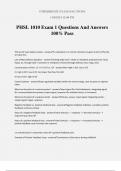©THEBRIGHT EXAM SOLUTIONS
11/8/2024 12:08 PM
PHSL 1010 Exam 1 Questions And Answers
100% Pass
The law of mass balance states - answer✔if a substance is to remain constant any gain must be offset by
an equal loss
Law of Mass Balance Equation - answer✔existing body load + intake or metabolic production (ex: food,
liquid, air, through skin) = excretion or metabolic removal (through kidneys, liver, lungs, skin)
Concentrations of Na+, Cl-, K+ in ECF vs. ICF - answer✔Na+ high in ECF, low in ICF
Cl- high in ECF, low in ICF, but lower than Na+ for both
K+ low in ECF, high in ICF
Control systems - answer✔keep regulated variables within the normal range, near set point or optimal
value
What are the parts of a control system? - answer✔Input signal (Ex: fluid imbalance), integrating signal
(Ex: nervous/endocrine system), output signal, response (Ex: breather faster, hr increases)
What are the parts of a response loop? - answer✔Stimulus, sensor, input signal, integrating center,
output signal, target, response
Negative feedback vs. positive feedback loop - answer✔Negative feedback stabilizes a variable, positive
feedback reinforces stimuli
Steps of a negative feedback loop - answer✔Initial stimulus --> response --> decrease stimulus -->
response loop shuts off
Steps of a positive feedback loop - answer✔Initial stimulus --> response --> increased stimulus -->
positive feedback cycle increases the response
-an outside factor is required to shut off a positive feedback cycle
Example of Positive Feedback Loop - answer✔Contractions of the uterus during childbirth
, ©THEBRIGHT EXAM SOLUTIONS
11/8/2024 12:08 PM
cervical stretch --> stimulates oxytocin release --> causes uterine contractions --> pushes baby against
the cervix --> causes cervical stretch etc. until baby is delivered
Example of Negative Feedback Loop - answer✔Regulating blood sugar
What is the body's response to high blood glucose levels? - answer✔Insulin is released by beta cells,
liver cells bind to insulin --> converted to glycogen --> blood glucose levels decrease --> less insulin is
released
What is the body's response to low blood glucose levels? - answer✔Alpha cells release glucagon --> acts
on target cells in liver --> liver cells break glucagon down to glucose --> blood glucose levels increase -->
less glucagon is released
Type 1 vs. Type 2 Diabetes - answer✔Type 1: no insulin is produced, therefore insulin-dependent
Type 2: insulin is produced, but target cells don't take up glucose
Axes of a graph - answer✔x axis is independent variable (ex: time), y axis is dependent variable (varies)
Four primary tissue types - answer✔Epithelial, connective, muscle, and nervous
Features of epithelial tissue - answer✔1. Usually covers a surface as a sheet of cells
2. Cells are applied closely to each other (little intracellular space
3. Cells are bound together by surface specializations
4. Rests on basal lamina (seals)
5. Always avascular: nutrition diffuses through basal lamina
Functions of epithelial tissue - answer✔1. Protection (internal + external)
2. Transport
3. Absorption
4. Secretion
5. Excretion
6. Sensory reception
7. Many involve epithelial specializations (sight, taste, smell)
Classification of Epithelial Tissue - answer✔1. Number of cell layers (simple= one layer, stratified =
multiple layers)
2. Shape of the cells (squamous = flat, cuboidal = square, columnar = rectangular)
Where are simple squamous cells found? - answer✔blood vessel, endothelium
, ©THEBRIGHT EXAM SOLUTIONS
11/8/2024 12:08 PM
Where are simple cuboidal cells found? - answer✔kidney tubules
Where are simple columnar cells found? - answer✔Small intestine
Where are pseudostratified columnar cells found? - answer✔Respiratory tract (have goblet cells which
secrete mucus)
pseudostratified columnar epithelium - answer✔Can tell they are still simple because all cells touch the
basal lamina
Where are stratified squamous cells found? - answer✔Vagina
Where are stratified cuboidal cells found? - answer✔Thin skin, sweat glands
Where are transitional cells found? - answer✔urinary tract and bladder (specialized for stretch)
What waterproofs the skin? - answer✔keratinous cells
Fluid Mosaic Model - answer✔3D arrangement of phospholipids and proteins within the cell membrane,
phospholipids arrange in bilayer with heads on the surface and this in the center, membrane is studded
with protein molecules and the ECF has glycoproteins and glycolipids.
-glycolipids respond to changed in the exterior
What are lipid rafts? - answer✔Lipid rafts are collections of phospholipid heads that serve as attachment
points for other biomolecules; these rafts often serve in signaling.
What is cholesterol's role in the lipid bilayer? - answer✔Gives the membrane fluidity and allows it to
change shape
What composes a phospholipid molecule? - answer✔1. Polar head
a. glycerol (in ALL lipids): polyalcohol, attaches to other molecules
b. Phosphate: highly polarized (hydrophobic)
c. Serine or coleine
2. Nonpolar tail: fatty acids
freeze fracture technique - answer✔Splits a membrane along the middle of a phospholipid bilayer at the
tails
Types of membrane proteins - answer✔1. integral proteins: membrane spanning, permanently
embedded with the PM
2. peripheral proteins: contain receptors or glycoproteins that only temporarily associate with the PM




